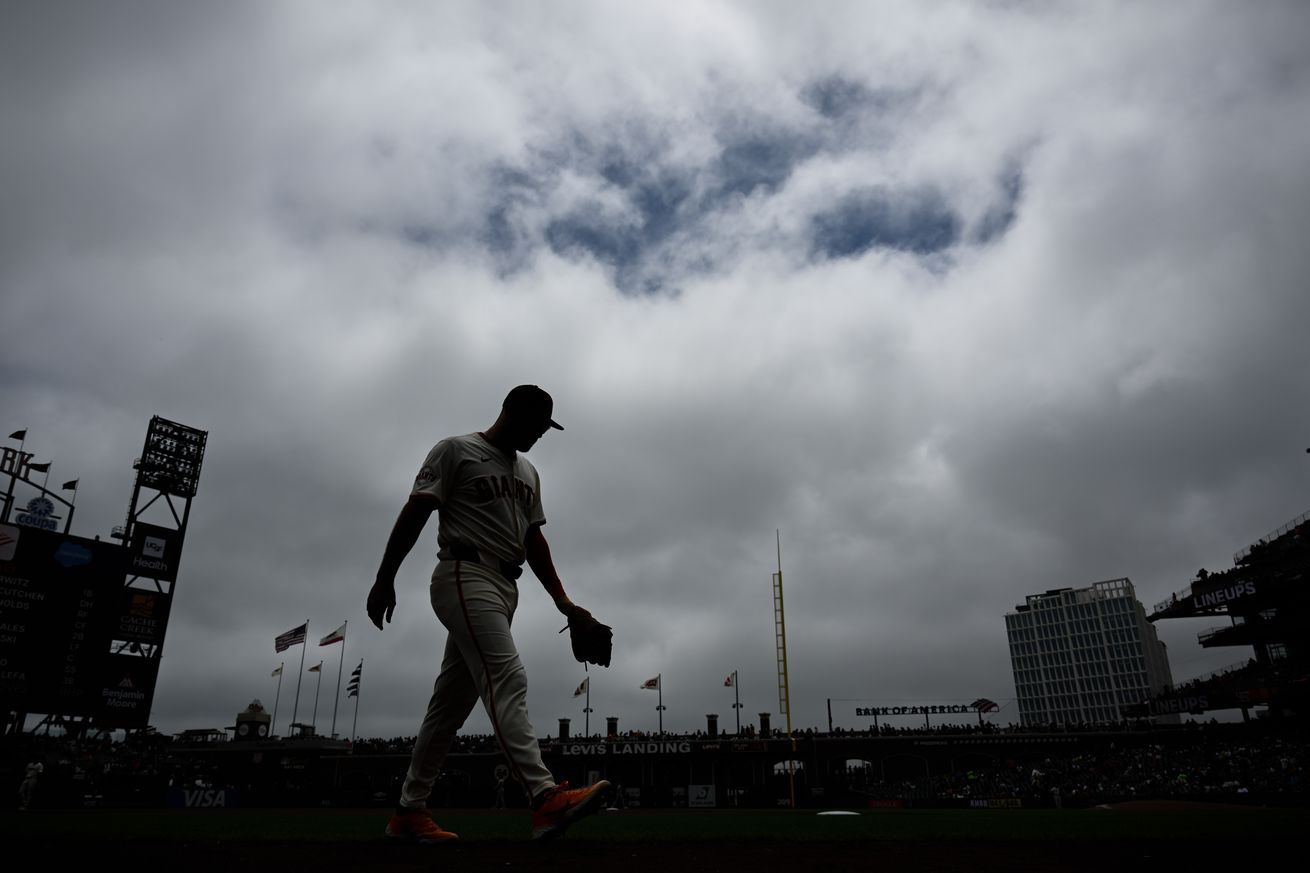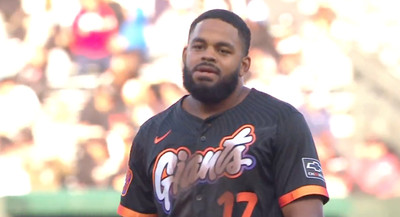
Hope this helps!
The San Francisco Giants have been playing hot garbage baseball for a month and a half now.
Since the All-Star Break They’ve dropped 10 of their last 12 in a majestic swan-dive out of postseason relevancy and are now below .500 for the first time all year. After back-to-back sweeps by a very good team (Mets) and a very bad team (Pirates), it’s clear their struggles have evolved beyond an eye sore, and become an odor, a stenchy mixture of stale sweat, rotting food scrap, and curdled milk.
For many of you, there’s little point in digging around in the muck for an explanation to the suck. We don’t need the why, we can just take in the forlorn gaze of Heliot Ramos and know, with full and complete understanding, that this summer has been a dog, one dopey, short-legged, out-of-breath, slobbery dog…that is confused about the infield fly rule.


That glazed-over look isn’t unique to Ramos. Logan Webb had a run of three starts in which he allowed 16 runs. Matt Chapman sprained his wrist, then took some time to find his swing again. Hayden Birdsong started doing his best Nuke LaLoosh impression and was sent back down to Triple-A because of it. Rafael Devers has hit the ball hard but hasn’t produced according to his established abilities, while making some expected, but still costly goofs playing first. It’s been a team effort. Pretty much everyone up and down the Giants roster, other than Willy Adames, has contributed to the malaise.
Devers’ arrival, in my mind, is the crossroads date. Not because San Francisco’s woes can be placed solely on his shoulders, but it was the early and bold move by Buster Posey at the deadline that announced the team’s 2025 intentions. This was supposed to be a turning point, a shift into a higher gear. They were going to make a push, they were going to compete now and compete in the future, and to do it, Posey pulled from a surplus of arms to help improve an offensive deficit. We can be picky about the specific players involved, but the overall logic of the deal made sense then, and it still makes sense despite the nonsense that followed.
The Giants were ten games above .500 on June 15th. Add one of the better hitters in the Majors over the last six seasons and nothing changed. The offense stayed stagnant. Take away a back-end rotation piece in Kyle Harrison (in terms of on-field results — organizationally he was more than this) and a bullpen-relegated arm in Jordan Hicks and the dominant and deep pitching corps suddenly looked threadbare and worn. They’ve posted an MLB-worse 13-24 record in the meantime (while the Red Sox keep winning…)
Pointing fingers can be cathartic. It’s easy to fall into vague and reflexive condemnations: Devers is a millstone, a clubhouse cancer; Harrison was the forsaken golden boy, the invisible stitch holding the entire fabric of the Giants’ universe together. I’m not convinced of either of those explanations, nor their productivity. But something happened. That dread you feel as the innings progress watching this recent iteration of the Giants is earned. There are numbers to explain why you feel this way.
Pre-trade ERA: 3.30 (3rd in Majors)
Post-trade: 4.32 (17th)
To be clear, Rafael Devers does not pitch. What happened with the rotation and the bullpen is not on him. The Giants’ success earlier in the season was built on the effectiveness of their arms. They had a bottom-5 offense, so they needed a top-5 staff to provide ballast — this counterweight the only way they were going to stay afloat. As the season wore on and workloads swelled, it was reasonable to expect some kind of regression, but the pitching got way worse than projected. They weren’t competitive with their previous performance nor were they measuring up with the rest of the league, causing the Giants to capsize.
ERA is just the jumping off point. Toggle around the leaderboards and see how the pitching problems are evident in every statistical category and split. The drop might be most noticeable if we get role specific. The bullpen was the statistical darling of the pitching corps, ranking in the top-2 of teams in many significant stats, and oh how they’ve fallen.
Pre-trade Reliever ERA: 2.67 (1st in Majors)
Post-trade: 4.17 ERA (15th)
Pre-trade Reliever WHIP: 1.13 (1st in Majors)
Post-trade: 1.27 (14th)
Pre-trade opponent’s wOBA: .274 (lowest in Majors)
Post-trade: .311 (15th)
Pre-trade Left On Base%: 78.1 (2nd in Majors)
Post-trade: 67.9 (24th)
We’ve felt this drop distinctly. Slim leads lost in the late innings, an inability to clean-up inherited messes. Innings have accumulated and the workload has increased. San Francisco starters logged a quality start in 46% of their games before June 16th. Since their rate is slightly below 33%. The bullpen’s 13 holds rank 25th in the Majors since mid-June. To compare: the Padres’ LOB%, a team who similarly rely on resolute relievers to help aid a lackluster offense, is 82.9% with 27 holds.
They haven’t plummeted in every category. Relievers are striking out batters at a slightly higher rate. They dropped their walk-rate considerably, and have managed to improve their excellent groundball rate to a league-leading 50%. But when opponents put the ball in play, they’re being rewarded. Their BABIP swelled to .310 helping their average jump from .207 to .255. Even with an elite groundball rate, the quality of contact has clearly improved. The Giants bullpen limited batters to a low 25.4 Hard% (Fangraphs) before the trade, and that rate has risen to around 30% — still in the top-10 but a noticeable drop. According to Statcast, opponents’ hard-hit rate sits around 40%, one of the higher rates in the league. Opponents slugging also grew from a league-low .322 to .409 (17th). Loud contact often produces contact of consequence.
Pitching has overall shown the biggest change since the Devers trade, but that doesn’t necessarily mean their performance has been the most frustrating to watch. The offense was the most maddening before the trade and it’s even more maddening after. Here, Devers can shoulder some blame. He was brought in to jumpstart the Giants’ thump, and the thump has not bumped. Devers strutted into the San Francisco clubhouse as an anti-Dave Parker decked out in a shirt that sheepishly stated: If you hear any noise, it’s [probably not] me and the boys boppin.
The overall offensive numbers haven’t changed much from pre- to post-. Despite the addition of Devers and Adames’s hot stretch, they’re all still pretty bad, which is of course, a significant problem. But that stagnation pales in comparison to how they’ve regressed in high leverage situations.
Pre-trade Clutch: 1.88 (2nd in Majors)
Post-trade: -1.11 (20th)
Pre-trade AVG w/ RISP: .251 (16th in Majors)
Post-trade: .191 (30th)
Pre-trade OPS w/ RISP: .772 (5th in Majors)
Post-trade: .553 (30th)
Pre-trade wRC+ w/ RISP: 114 (4th in Majors)
Post-trade: 57 (30th)
The Giants have been the worst at capitalizing on favorable offensive situations. And opponents in fraught situations have escaped with little or no punishment. We saw this last weekend against the Mets, when the line-up went 0-for-100,000 with a runner in scoring position. That 57 wRC+ is not only the lowest mark in the Majors since June 16th, but the lowest by far, barely within shouting distance of Pittsburgh’s 71.
The one thing the offense had going for them was this miraculous resilience to flip close games in their favor. The elite, buck-stops-here pitching and clutch hitting tag-teamed to produce that top-8 record, and both for the most part disappeared over the last month and a half.